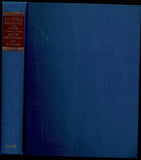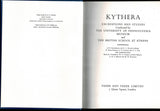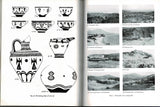Kythera Excavations And Studies Conducted by THe University Of Pennsylvania Museum and The British School At Athens
Author: John Nicolas "J N" Coldstream (1927-2008) and George L Huxley editors
Year: 1972
Publisher: London
Place: Stroud
Description:
319+96 illustrations (some folding)+88 plates pages with figures, diagrams, maps, plans, plates and appendixes. Quarto (11 1/4" x 8 1/2") bound in original publisher's blue cloth with gilt lettering to spine in original pictorial jacket. Contributions by R Hope Simpson, J F Lazenby, A S Trik, Bernard Anderson, W G Forrest, Judith Herrin, A H S Megaw and W H Plommer. First British edition.
Kythira is an island in Greece lying opposite the south-eastern tip of the Peloponnese peninsula. It is traditionally listed as one of the seven main Ionian Islands, although it is distant from the main group. There are archaeological remains from the Helladic period, contemporary with the Minoans. There is archaeological evidence of Kythiran trade as far as Egypt and Mesopotamia. Kythira had a Phoenician colony in the early archaic age; the sea-snail which produces Tyrian purple is native to the island.[citation needed]Xenophon refers to a Phoenician Bay in Kythira (Hellenica 4.8.7, probably Avlemonas Bay on the eastern side of the island). The archaic Greek city of Kythira was at Scandea on Avlemonas; its ruins have been excavated. Its acropolis, now Palicastro (Palaeocastron, "Old Fort"), has the temple of Aphrodite Ourania, who may well represent a Phoenician cult of Astarte. In classical times, Kythira was part of the territory of several larger city-states. Sparta took the island from Argos early in the sixth century, and ruled it under a kytherodíkes (kυθηροδίκης, "judge on Kythira"), in Thucydides' time [4,53,3]; Athens occupied it three times when at war with Sparta (in 456 during her first war with Sparta and the Peloponnesians; from 426 to 410, through most of the great Peloponnesian War; and from 393 to 387/386, during the Corinthian War against Spartan dominance) and used it both to support her trade and to raid Laconia.
Condition:
Spine ends and corners gently bumped and rubbed some pencil marginalia throughout. Jacket spine ends chipped with tears, edge wear with tears and chips, lightly soiled else very good in about very good jacket.















